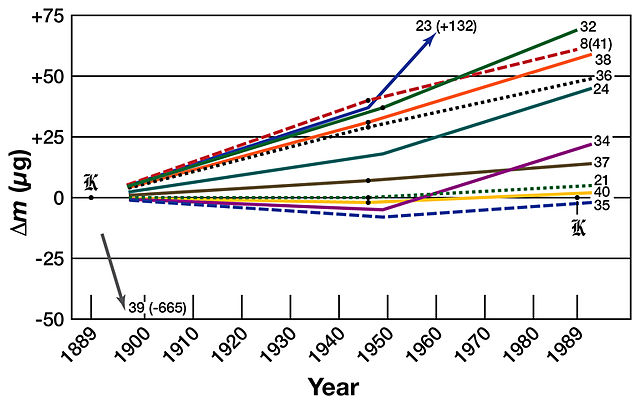 |
This is a file from the Wikimedia Commons. Information from its description page there is shown below.
Commons is a freely licensed media file repository. You can help.
|
| Description |
English: A graph of the relative change in mass of selected kilogram prototypes. From The Third Periodic Verification of National Prototypes of the Kilogram (1988—1992), G. Girard, Metrologia 31 (1994) 317—336. The International Prototype Kilogram (IPK) kept in Sevres, France, and the other national prototype kilogram standards have been found to vary in mass over the years. Since the IPK defines the kilogram, the only way to detect changes in mass is to compare the mass of the prototypes, which is done every 40 years. This graph shows the "mass drift" of the numbered prototypes compared to the IPK.
- The IPK is represented by the stylized K in an old-English typeface.
- No. 39, which lost 665 µg relative to the IPK, had originally been allocated to Japan in 1894. In 1958, following the Second World War, it was ceded to the Republic of Korea.
- No. 23 was allocated to Finland in 1890.
- No. 8(41) was accidentally stamped with the number 41, but its accessories carry the proper number 8: since there is no prototype marked 8, this prototype is referred to as 8(41).
|
| Date |
2007-12-11 (first version); 2007-12-10 (last version) |
| Source |
Transferred from en.wikipedia; transferred to Commons by User:Choihei using CommonsHelper. |
| Author |
Original uploader was Greg L at en.wikipedia |
Permission
( Reusing this file) |
Licensed under the GFDL by the author; GFDL-SELF-NO-DISCLAIMERS; Released under the GNU Free Documentation License.
|
 |
This graph image could be recreated using vector graphics as an SVG file. This has several advantages; see Commons:Media for cleanup for more information. If an SVG form of this image is already available, please upload it. After uploading an SVG, replace this template with {{ vector version available|new image name.svg}}. |
Licensing
Greg L at the English language Wikipedia, the copyright holder of this work, hereby publishes it under the following license:
 |
Permission is granted to copy, distribute and/or modify this document under the terms of the GNU Free Documentation License, Version 1.2 or any later version published by the Free Software Foundation; with no Invariant Sections, no Front-Cover Texts, and no Back-Cover Texts. A copy of the license is included in the section entitled GNU Free Documentation License. http://www.gnu.org/copyleft/fdl.htmlGFDLGNU Free Documentation Licensetruetrue
|
|
I, the copyright holder of this work, hereby publish it under the following license:
 |
Permission is granted to copy, distribute and/or modify this document under the terms of the GNU Free Documentation License, Version 1.2 or any later version published by the Free Software Foundation; with no Invariant Sections, no Front-Cover Texts, and no Back-Cover Texts. A copy of the license is included in the section entitled GNU Free Documentation License. http://www.gnu.org/copyleft/fdl.htmlGFDLGNU Free Documentation Licensetruetrue
|
|
File usage
The following pages on Schools Wikipedia link to this image (list may be incomplete):
This file contains additional information, probably added from the digital camera or scanner used to create or digitize it. If the file has been modified from its original state, some details may not fully reflect the modified file.
Schools Wikipedia has been carefully checked to give you the best learning experience. SOS Children believes education is an important part of a child's life. That's why we ensure they receive nursery care as well as high-quality primary and secondary education. When they leave school, we support the children in our care as they progress to vocational training or higher education. Why not try to find out more about sponsoring a child?




